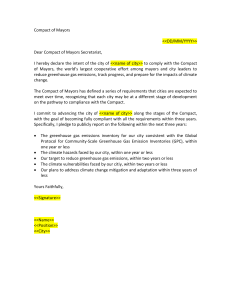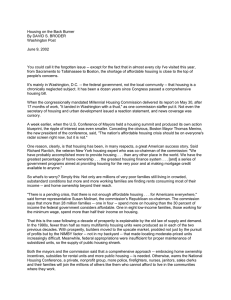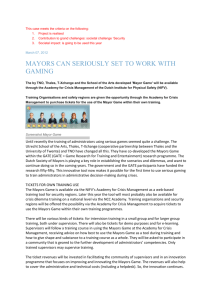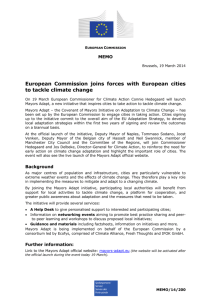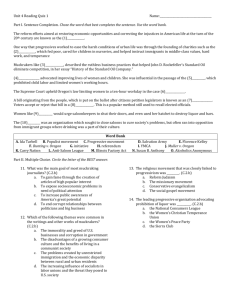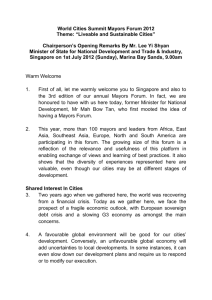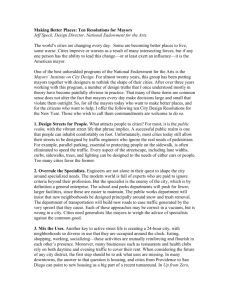Climate Mitigation and Adaptation Actions in America`s Cities
advertisement
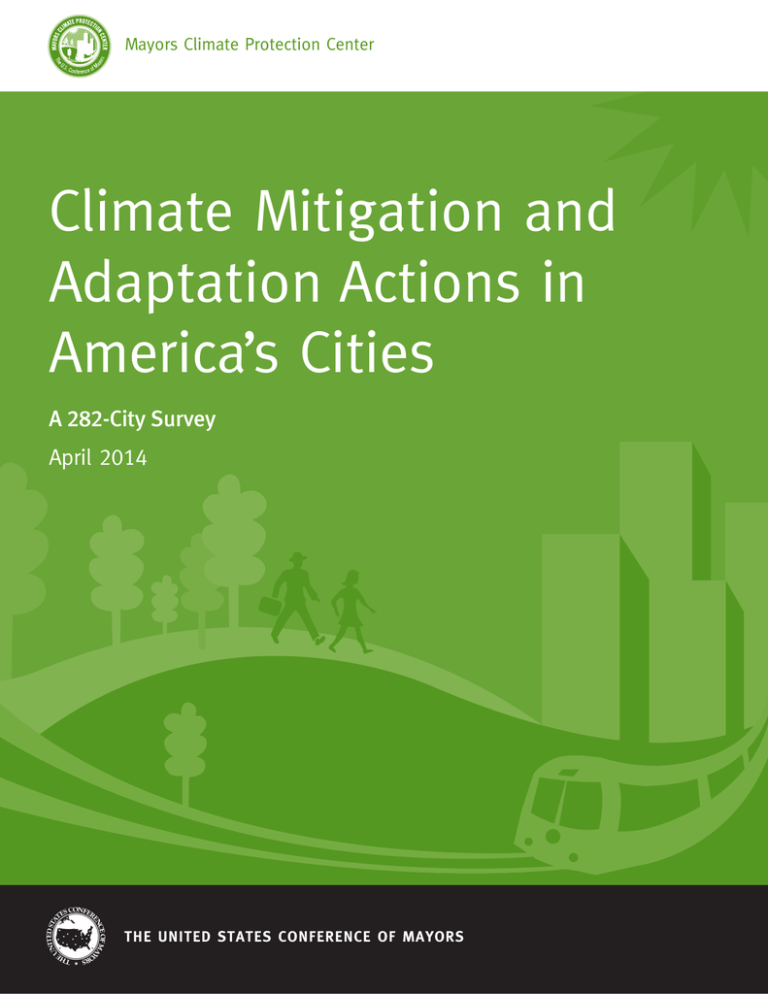
Mayors Climate Protection Center Climate Mitigation and Adaptation Actions in America’s Cities A 282-City Survey April 2014 THE UNITED STATES CONFERENCE OF MAYORS THE UNITED STATES CONFERENCE OF MAYORS Kevin Johnson Mayor of Sacramento President Stephanie Rawlings-Blake Mayor of Baltimore Vice President James Brainard Mayor of Carmel Co-Chair, Energy Independence and Climate Protection Task Force Bill Finch Mayor of Bridgeport Co-Chair, Energy Independence and Climate Protection Task Force Tom Cochran CEO and Executive Director The U.S. Conference of Mayors is the official nonpartisan organization of cities with populations of 30,000 or more. There are 1,398 such cities in the country today, each represented in the Conference by its chief elected official, the Mayor. do your part! please recycle! Fo re word Our nation’s mayors continue to lead the way in curbing carbon emissions in hundreds of U.S. cities and their metro areas, with many of these local leaders now working to adapt their cities and vital public systems in this era of increasingly unpredictable and destructive climatic events. Mayors’ climate action has proven to be a very resilient movement, from its beginnings in 2005 when a group of U.S. mayors came together to pledge local action to reduce Tom Cochran CEO and Executive Director The United States Conference of Mayors carbon emissions and to call on state and federal leaders to do their part. Over the years, this mayoral initiative grew to more than 1,000 mayors, with each pledging to curb city climate emissions by joining as a signatory to the Mayors’ Climate Protection Agreement. This voluntary mayoral commitment has underpinned some of our recent success in reducing U.S. greenhouse gas emissions, as these findings indicate. And, we know that the future is about continuing to take the many local (and state and federal) actions that will systematically move us toward our climate goals. Successful city efforts to use energy more efficiently and deploy new energy technologies, especially renewable energy supplies, are areas prominently featured in Conference survey reports released earlier this year. The survey report being released today, Earth Day 2014, focuses on mayoral climate leadership, mostly local mitigation efforts, to document how mayors are working to reduce GHG emissions and quantify these reductions. To be sure, these findings appear to just scratch the surface of all that is underway and being achieved in our cities. Yet, we see that these actions are making a difference, locally and nationally. We know there is much more to do in this regard, but the findings provided here surely indicate that mayors are continuing to lead the way. We are all very grateful for their leadership and their hard work in this regard. The United States Conference of Mayors 1 Mayors Climate Protection Center Su rvey Re s ul t s Almost every mayor participating in The U.S. Conference of Mayors’ 2014 energy efficiency and technologies survey provided information on city-based climate activities. Specifically, this report is based largely on queries relating to mayoral climate mitigation and adaptation efforts. It excludes related information on mayoral energy initiatives, which was released earlier this year by the Conference of Mayors. This survey report is the third in a series. The first survey report, Energy Efficiency and Technologies in America’s Cities, was released January 2014 during the Conference of Mayors’ 82nd Winter Meeting in Washington, DC. The second report, Successful City Initiatives with Energy Efficiency and Conservation Block Grant (EECBG) Funding, was released late February 2014. Both surveys report on many of the key city energy practices and activities which so often underpin mayoral climate efforts. Nearly all mayors in the larger survey – 282 of 288 respondents – provided data on their respective climate initiatives, offering perspectives from cities of all population sizes and from all regions of the country. These climate-related responses are reported in the following findings. By official action (i.e., mayoral pledge or formal city council action), more than half of all cities are now reducing their carbon emissions. A majority of cities (53%) – 149 of the 282 cities – have committed to reducing greenhouse gas (GHG) emissions as the result of a mayoral pledge and/or formal city council action. Has Your City by Official Action Committed to Reducing GHG Emissions (percentage of cities) Yes 53% No 47% The share of cities working to reduce carbon emissions under a mayoral pledge/formal city council action, as shown in this chart, is certain to understate the scale of city commitments to reduce GHG emissions, as noted later in this report (and in other earlier Conference surveys). The United States Conference of Mayors 3 Mayors Climate Protection Center Survey Results For cities operating under a mayoral pledge/formal city council action to reduce carbon emissions, more than two-thirds indicate their actions resulted in quantifiable greenhouse gas reductions. More than seven in ten cities (71%) with formal mayoral/city council actions calling for reductions in city carbon emissions say their actions have resulted in quantifiable GHG reductions in city government operations and/or the community at large. More than four in ten cities (41%) report quantifiable GHG reductions for city operations, with about one-quarter saying their actions have resulted in quantifiable reductions for city operations and the community at large. Quantifiable GHG Reductions from City Actions (percentage of cities) Quantifiable reductions for city government operations and the community at large 26% Don’t know 29% Quantifiable reductions for community at large 4% Quantifiable reductions for city government operations 41% Almost half of all cities surveyed have conducted a greenhouse gas (GHG) inventory. Nearly half of the cities (48%) have conducted an inventory of greenhouse gases. Has Your City Conducted a Greenhouse Gas (GHG) Inventory (percentage of cities) Yes 48% The United States Conference of Mayors No 52% 4 Mayors Climate Protection Center Survey Results Taken together, these two initial findings – mayoral pledge/city council action and status of inventory – indicate that more cities are taking action to reduce carbon emissions than the charts suggest. Survey data show that one in nine cities (11%) have conducted a GHG inventory, outside of any mayoral pledge or formal city council action. Moreover, nearly one-third of cities (31%) with a mayoral pledge/formal city council action have not conducted any GHG inventory. Not shown in this survey are cities reducing emissions, absent a mayoral pledge/city council action and inventory. Of those cities with a GHG inventory, nearly six in ten conducted it for city operations and the community at large. A sizable majority of the cities (59%) that undertook an inventory of greenhouse gases did so for city operations as well as the community at large. More than one-third of these cities (34%) limited their GHG inventory to city government operations only, with about one in 15 cities (7%) conducting an inventory only for the community at large. Among cities with an inventory, more than nine in ten cities (93%) have data on emissions from cities operations, with two in three cities (66%) for the community at large. Focus of Your City’s Greenhouse Gas (GHG) Inventory (percentage of cities) Conducted a GHG inventory for city government operations 34% Conducted a GHG inventory for city operations and the community at large 59% Conducted a GHG inventory for the community at large 7% A majority of mayors are creating programs to engage local residents in reducing greenhouse gas emissions (GHGs) as their priority among other community-wide engagement initiatives. Asked to choose among six climate-related community engagement activities, the first choice of mayors are programs that engage local residents in reducing emissions (54%). After working with residents, mayors turn to their business community (45%) to support city efforts to reduce emissions. Four in ten cities are developing a climate adaptation plan for the city (40%), and the same percentage is undertaking assessments and/or creating community-wide responses to predicted climate impacts (40%). The United States Conference of Mayors 5 Mayors Climate Protection Center Survey Results Engaging the Local Community on Climate Activities (percentage of cities) Creating programs for residents 54% Creating programs for businesses 45% Purchasing clean energy supplies/offsets 42% Developing climate adaptation plan 40% Assessing/creating responses to expected climate impacts 40% Providing incentives to businesses 17% NOTE: Seven in ten cities (203 out of 288 cities) participating in the survey provided responses to this question. City best practices top the list of non-financial resources that are most helpful to mayors in advancing their city energy and climate goals. Nearly three in four cities (74%) rank city best practices as the most useful resource among other offerings in achieving their local goals. Two-thirds of cities want energy use data for their city (67%), followed by city surveys and data on what other cities are doing (57%). Nearly every participant in the survey (279 of 288 cities) provided responses to this query on “most helpful resources.” Resources for Advancing Energy and Climate Goals (percentage of cities) City best practices 74% Energy use data for your city 67% City surveys and data on other cities 57% Financial structures on lending/borrowing 50% Public-private partnerships case studies 48% Federally-sponsored topical webinars 36% LED/efficient lighting was overwhelmingly rated as the “most promising” technology for reducing city energy use and carbon emissions. Cities again made LED/other energy-efficient lighting their top choice for most promising technology, with more than four in five cities (82%) making this selection. This preference is higher that the Conference’s 2011 survey, Clean Energy Solutions for America’s Cities, when about three-quarters (76%) of all cities cited LED/other efficient lighting technologies. The United States Conference of Mayors 6 Mayors Climate Protection Center Survey Results Most Promising Technologies for Reducing Energy Use and Carbon Emissions (percentage of cities) 82% LED/other energy-efficient lighting 54% Solar electricity generation 53% Low-energy buildings 40% Compressed natural gas (CNG) vehicles 36% Hybrid vehicles 32% Energy-efficient appliances/pumps/other systems 20% All electric vehicles 16% Energy-efficient water treatment technology 15% Smart grids/smart meters monitoring energy use 12% Waste-to-energy conversion 11% Methane capture (landfills/biosolids) 10% Solar hot water 9% Geothermal 8% Cogeneration (combined heat & power) 7% Wind turbines In addition to lighting, there are notable changes in the views of cities on other technologies. Compressed natural gas (CNG) vehicles – identified by more than four in ten cities (40%) – doubled its selection rate (20%) from the prior survey. Solar electricity generation is now the cities’ second choice (54%), edging out low-energy buildings, which dropped significantly (from 68% to 53%). Energy-efficient appliances/pumps/other systems, likewise, is also viewed less favorably (32% compared to 44% in 2011), falling from fourth to sixth place among 20 technology categories. While slightly more than one-third of survey respondents have developed a broad-based energy plan, the share of cities with such plans is expected to more than double in three years. Today, 36 percent of cities already have “comprehensive” energy plans; this share will change dramatically over the next three years. Nearly four in five cities (79%) are expected to have developed plans by 2016. Cities with Comprehensive Energy Plans (percentage of cities) Developed Within 1 year Within 2 years Within 3 years 36% 36% 44% 62% 44% 62% 79% In separate queries of the 103 cities with plans in place, a substantial majority (83%) include energy reduction targets for city operations and citywide energy use. Six in 10 (60%) cities include specific targets in these plans for the use of renewable energy in city operations or by the broader community. The United States Conference of Mayors 7 Mayors Climate Protection Center Survey Results Three-quarters of cities have developed an energy emergency response plan that maintains key municipal services during power outages. Three in four cities (76%) have plans in place to sustain key municipal functions during power outages. For those cities without an energy emergency response plan, one-half expect to have such a plan developed within three years, raising the share of cities to nearly nine in ten (88%). In a related query, cities were asked if they had been affected by a power outage(s) within the past five years due to a severe climate event (e.g., major hurricane, tornado, significant snow or ice storm, major flooding). More than four in ten (41%) cities responded affirmatively, providing details on follow-up actions that were taken to respond to future events, as shown below. Power Outages and Local Energy Emergency Response Plan Changes (percentage of cities) Modified existing city energy emergency plan 52% Revised agreements with utilities/energy suppliers 45% Installed larger-scale power systems (e.g., gas turbines, fuel cells) 38% Engaged/educated citizens/businesses 35% Identified additional federal/state actions 35% Modified key infrastructure (e.g., transmission lines, substations) Adopted new city energy emergency plan 20% 11% Each mayor was asked to identify just ONE federal policy change to help adapt/retrofit the city’s infrastructure and/or better prepare for climatic events or climate change, with respondents calling for additional federal funding assistance to cities as the top priority. The following summarizes many of these mayoral recommendations, grouping them under key headings. More than 110 cities responded to this query, with cities providing their recommendations in their own words. Generalized Funding: Recommendations urging additional federal funding assistance to cities was the top category among survey respondents, with nearly one in three cities urging more federal funding support, including those calling for additional EECBG resources. Many cities expressed their suggestions using many different phrases: funding resources, funding support, grants, energy block grants, more funding opportunities, and predicable annual appropriations, among others. Some cities suggested specific purposes for new funds to local areas, such as funding for performance, funding for preparedness strategies, funding for adaptation action areas, and funding to capitalize revolving loan funds. EECBG Funding: Beyond generalized calls for federal assistance to cities, several respondents specifically urged renewed funding for the Department of Energy’s Energy Efficiency and Conservation Block Grant Program, offering various suggestions on what to emphasize with the funds. One city urged an “annual EECBG allocation to local governments for mitigation and adaptation activities.” Another suggested continued EECBG funding to serve as a driver “to promote upgrades in private residences and businesses as well as city infrastructure.” One city suggested that EECBG funding should be coupled with increased federal administrative support, like HUD’s Community Development Block Grant Program, so that the federal government is a partner in supporting local investments and innovations. EECBG funding should be used for “infrastructure renovations,” suggested another city. The United States Conference of Mayors 8 Mayors Climate Protection Center Survey Results Targeted Incentives: In addition to providing additional federal resources directly to cities and other local areas, several cities called for more targeted funding initiatives. One urged a large commitment of federal funds for climatic event planning and preparedness. “We need resources (data, technical assistance) to help us better understand the specific ways that climate change is expected to impact our community and what those impacts mean for infrastructure systems,” said one city. Another called for the development of a nationwide financing mechanism for home energy retrofits (on-bill financing). Owners of solar panels should receive a 30 percent federal tax credit when leasing the panels to a non-profit/government organization, according to another. Tax credits/incentives to commercial property owners and businesses to retrofit existing buildings and install renewable energy in new commercial development (with the same assistance multi-family developers and property owners) were urged. Financial resources and incentives for the deployment of distributed energy were also cited in another instance. One city urged the adoption of landscape grants, tax incentives and rebates to facilitate local adaptation efforts. “Streamline and expand federal funding for renewable energy research and development to make energy cleaner, more reliable, and more secure,” said another. Other Business Incentives: Beyond mandating actions, some cities called for federal financial incentives to the private sector. Another called upon Congress to “keep the investment tax credit.” Another called for “federal action to provide new energy tax credits for both commercial and residential buildings.” Federal Climate Policy: Congress should enact comprehensive climate legislation, recommended one city, while another simply urged Congress to “adopt a climate change policy.” As a first step, another city called for enactment of new federal energy efficiency legislation. Several cities urged adoption of a carbon tax; one city said, “To affect the price of the resource.” One survey respondent called for legislation “to institute a carbon tax and rebate program.” Another said, “The federal government needs to set a price on carbon emissions.” Other Federal Actions: Several federal actions were recommended by cities. One city urged the adoption of a national map, showing 25-year and 50-year projections of impacts so that local efforts and work can be better coordinated and aligned. Another urged adoption of a timeline, detailing when large side-effects of global warming are estimated to occur. One respondent simply said, “Support urbanization and give cities the resources to become the place citizens relocate to.” Stricter CAFE standards and GHG emission limits for electric utilities were cited by another city. Priority should be given to generation systems (e.g., rooftop solar panels) that can continue to provide power in the event of disruptions to the grid, another urged. Mandates on Government: Several cities urged adoption of selected mandates on governments, including “mandating efficiency levels and then funding the required improvements in those cities/counties to meet those levels through grants, matching funds, or low/no interest loans.” The federal government should require all states to have renewable portfolio standards was another recommendation. One city urged that “LED lighting be utilized in all traffic signals, street lighting, and security lighting throughout the city.” Another called upon “FEMA to require local governments to inventory, assess, and address climate preparedness as an element of natural hazards mitigation planning and a requirement for post-disaster mitigation funds from FEMA.” It was suggested the federal government should “require more complete participation from municipalities in how State Energy Program funding is distributed,” noting that this approach could allow for more resources to be leveraged to support local efforts. Mandates on Business: Several cities urged federal action to impose broader mandates on industry and the private sector. One urged adoption of a national energy code or standard for buildings, similar to the mpg standard for the auto industry. Another urged federal mandates requiring American-manufactured EEC equipment. Requiring the use of renewable energy, supported with technological and financial resources from the federal government, was recommended by another city. The United States Conference of Mayors 9 Mayors Climate Protection Center Part icipati ng Ci t i e s Fairbanks, AK Juneau, AK Montgomery, AL Fort Smith, AR Little Rock, AR Avondale, AZ Casa Grande, AZ Goodyear, AZ Lake Havasu City, AZ Mesa, AZ Oro Valley, AZ Phoenix, AZ Queen Creek, AZ Surprise, AZ Tempe, AZ Tucson, AZ Alameda, CA Alhambra, CA Anaheim, CA Beverly Hills, CA Cathedral City, CA Chula Vista, CA Compton, CA Costa Mesa, CA Culver City, CA Dublin, CA Fontana, CA Fresno, CA Gardena, CA Hemet, CA Huntington Beach, CA Irvine, CA La Habra, CA Long Beach, CA Los Angeles, CA Manhattan Beach, CA Monrovia, CA Newark, CA Newport Beach, CA Novato, CA Ontario, CA Palm Desert, CA Palmdale, CA Pasadena, CA Paso Robles, CA The United States Conference of Mayors Pleasant Hill, CA Pleasanton, CA Porterville, CA Redding, CA Redondo Beach, CA Rialto, CA Sacramento, CA San Clemente, CA San Diego, CA San Jose, CA San Leandro, CA San Rafael, CA Santa Ana, CA Santa Barbara, CA Santa Cruz, CA Santa Monica, CA Santee, CA South San Francisco, CA Stanton, CA Tulare, CA Turlock, CA Vallejo, CA Ventura, CA Westminster, CA Woodland, CA Aurora, CO Denver, CO Englewood, CO Westminster, CO Bridgeport, CT Danbury, CT East Hartford, CT Fairfield, CT Milford, CT Norwich, CT Stamford, CT Torrington, CT Trumbull, CT Vernon, CT Waterbury, CT West Haven, CT Washington, DC Wilmington, DE Boynton Beach, FL Cape Coral, FL 10 Cooper City, FL Coral Springs, FL Davie, FL Deerfield Beach, FL Doral, FL Fort Myers, FL Greenacres, FL Hallandale Beach, FL Jacksonville, FL Lakeland, FL Largo, FL Lauderhill, FL Miramar, FL North Lauderdale, FL North Miami, FL Orlando, FL Palm Bay, FL Panama City, FL Pembroke Pines, FL Pinellas Park, FL Pompano Beach, FL Port St. Lucie, FL Tallahassee, FL West Palm Beach, FL Athens-Clarke County, GA Atlanta, GA Columbus, GA Fairburn, GA LaGrange, GA Macon, GA Savannah, GA Maui, HI Davenport, IA Des Moines, IA Dubuque, IA Urbandale, IA Boise, ID Idaho Falls, ID Alton, IL Aurora, IL Elk Grove, IL Evanston, IL Glendale Heights, IL Hanover Park, IL Hoffman Estates, IL Mayors Climate Protection Center Participating Cities Lake Barrington, IL Lombard, IL Moline, IL Normal, IL North Chicago, IL Orland Park, IL Schaumburg, IL Carmel, IN Indianapolis, IN Noblesville, IN Richmond, IN Olathe, KS Shawnee, KS Lexington, KY Louisville, KY Baton Rouge, LA New Orleans, LA Ville Platte, LA Boston, MA New Bedford, MA Newton, MA Revere, MA Springfield, MA Weymouth, MA Baltimore, MD District Heights, MD Frederick, MD Laurel, MD Portland, ME Dearborn, MI Detroit, MI East Lansing, MI Eastpointe, MI Farmington Hills, MI Grand Rapids, MI Grosse Pointe Woods, MI Jackson, MI Rochester Hills, MI Southfield, MI Troy, MI Westland, MI Burnsville, MN Eagan, MN Edina, MN Minneapolis, MN Minnetonka, MN Rochester, MN Columbia, MO Kansas City, MO St. Louis, MO University City, MO The United States Conference of Mayors Natchez, MS Butte, MT Burlington, NC Charlotte, NC Fayetteville, NC Gastonia, NC Greenville, NC Salisbury, NC Winston-Salem, NC Grand Forks, ND Lincoln, NE Nashua, NH Brick Township, NJ Clifton, NJ Elizabeth, NJ Ewing, NJ Kearny, NJ Linden, NJ Piscataway, NJ Albuquerque, NM Clovis, NM Santa Fe, NM Carson City, NV Henderson, NV Las Vegas, NV North Las Vegas, NV Reno, NV Albany, NY Clarence, NY Schenectady, NY Syracuse, NY Akron, OH Cleveland, OH Columbus, OH Cuyahoga Falls, OH Dayton, OH Lancaster, OH Lima, OH North Ridgeville, OH Trotwood, OH Warrensville Heights, OH Tulsa, OK Beaverton, OR Bend, OR Gresham, OR Hillsboro, OR Lake Oswego, OR Portland, OR Tigard, OR Lancaster, PA Philadelphia, PA 11 Pittsburgh, PA Wilkes-Barre, PA York, PA Caguas, PR Providence, RI Charleston, SC Summerville, SC Sioux Falls, SD Chattanooga, TN Hendersonville, TN Johnson City, TN Knoxville, TN Memphis, TN Morristown, TN Abilene, TX Corpus Christi, TX Dallas, TX Denton, TX Fort Worth, TX Frisco, TX Garland, TX Houston, TX Irving, TX Kyle, TX Mesquite, TX Pharr, TX Plano, TX San Antonio, TX Sugar Land, TX Lehi City, UT Salt Lake City, UT Sandy, UT South Jordan, UT Taylorsville, UT Alexandria, VA Norfolk, VA Roanoke, VA Burlington, VT Duvall, WA Everett, WA Pullman, WA Redmond, WA Seattle, WA Tacoma, WA Vancouver, WA Brookfield, WI Green Bay, WI Madison, WI Milwaukee, WI Huntington, WV Gillette, WY Mayors Climate Protection Center About the Sur ve y This report was prepared by The U.S. Conference of Mayors and was based on data collected in a mayoral survey sponsored by Philips. From November 25, 2013 through January 14, 2014, cities could complete the survey electronically. By email, the Conference contacted nearly 1,400 mayors, most representing cities with a population of 30,000 or more, requesting mayors to compete the survey. Survey responses from 282 cities were received and analyzed for this report. We would like to thank all those who participated in the survey for their efforts and timely responses. The United States Conference of Mayors 12 Mayors Climate Protection Center The United States Conference of Mayors 13 Mayors Climate Protection Center THE UNITED STATES CONFERENCE OF MAYORS Tom Cochran, CEO and Executive Director 1620 Eye Street, NW Washington, DC 20006 Tel: 202.293.7330 Fax: 202.293.2352 usmayors.org
